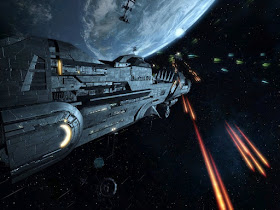The Shiny
The 61-page $8 pdf had plenty of colour pictures and (my favourite) miniatures in action. The rules are rather simple and easy to read with generous sized font. Usually I insist on a "Quick Reference Sheet" or a index but CROM doesn't need them - you can quickly flick through to find anything you need - without your glasses! (Note: Rules are free on the website but the pdf saves a lot of mucking around). There is even a free supplement available.
The Mechanics
This is the primary reason this game interested me. Heroes have a "dice pool" which represents their life or strength. These dice can be assigned to "movement" "combat" or "special".
Dice are rolled and totalled - or (and this is an interesting risk vs reward/resource management) they can be "burned". You can pick a dice to be an automatic '6' but it is permanently lost from your "dice pool" - due to the hero over-exerting himself to perform the amazing feat... Dice can be used in any order - or even kept for later (for example, retaining combat dice to defend against an opponent).
This unit card shows a very Frazetta-looking Death Dealer, from Bronze Age Miniatures
Whilst Heroes have a dice pool which can be assigned any way they wish, Minions have "set" dice (e.g. 2 movement, 2 combat, 0 special). They activate in groups of 3-5 and are basically cannon-fodder (like they are in the movies).
Movement is up to the total rolled by movement dice. Rules include jumping, climbing (and falling, naturally; and horses (which add movement dice).
Bronze Age Miniatures are a good source of Conan miniatures
In combat players allocate dice to attack or defence. They compare totals, with the highest succeeding. An successful attacker gets 2 hits, +1 hit each '6' rolled; a successful defender gets 1 hit,with +1 for every '6'. Hits are removed from the loser's die pool.
Special actions are kinda a catch all for stuff like magic, initiative and shooting.
Initiative is card-based, but players who have allocated dice to initiative may roll to go first or "jump the queue". Shooting is just like combat, only there is no extra +1 hits for '6's. Magic focusses on Conan-esque spells.
Another Bronze Age miniature - used to good effect in the scenario photo below...
Magicians "burn" their dice until they have filled the dice pool of the Summoned creature. Good wizards might get a better conversion rate - 1 dice spent gets you 2 dice worth of summoned monsters. Poor ones might require a human sacrifice as well... Once summoned, entities must be controlled with magic rolls. A failure means the entity is out of the player's control - and probably hungry. There are other forms of more "direct" magic such as fireballs, healing and shielding. Attacking another wizard with magic is quite risky - a magical "wiz vs wiz" duel works rather like combat.
I love the equipment cards used in scenarios... the art is simple and quirky throughout
In addition, there are rules for fire, poison, and example campaigns which showcase Matakishi's lovely terrain boards and miniatures. Fighting slavers in the market, making a prison break, raiding tombs, rescuing a scantily clad maiden from a dark jungle citadel fighting snake men, skeletons and giant grave worms - it's all in a day's work for Conan. And it's all in the pdf as scenarios - accompanied with inspirational photos of miniatures and scenery.
Will Conan interrupt the ritual in time?
(Photo from Matakishi's Teahouse - a great wargaming resource - check it out)
TL:DR
Simple, innovative and fun rules that use the "dice pool" to incorporate interesting resource management (assigning and 'burning' dice).
I wouldn't say these rules are terribly "deep" (they lean towards the "Song of Blades and Heroes" end of the simplicity spectrum) which may hurt their replayability - but as an excuse to get some awesome Conan minis on the table they can't be beat.
The scenarios are fun and the scenery is inspirational. You can even read the rules without squinting!
Pretty much all the rules content is available for free here - along with scenarios, unit cards, play examples - and even a "how-to" guide to make some of the great scenery shown.
Recommended: $8 to a good cause? Cheap as a meal at MacDonalds. And the rules are interesting and fun. What are you waiting for - get your Conan on!

























